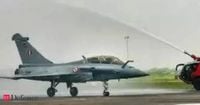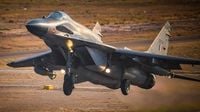NEW DELHI: In a decisive show of military strength, India has launched high-intensity aerial exercises dubbed "Operation Aakraman" involving its advanced fighter jets, including the Rafale and Sukhoi, following a recent terror attack in Pahalgam. The exercise, which began on April 24, 2025, has raised alarms in Pakistan as tensions escalate between the two nations.
Operation Aakraman, primarily taking place in Central India, aims to test and demonstrate the Indian Air Force's capabilities in complex scenarios, including ground assaults and electronic warfare. The Rafale jets, known for their precision and advanced technology, have been deployed from the Ambala and Hashimara airbases. This operation is particularly significant as it comes in the wake of heightened security concerns following the attack on tourists in Pahalgam, which has intensified the already fraught relations between India and Pakistan.
Sources indicate that the exercise simulates precision air strikes in an environment where the enemy possesses significant air defenses and electronic warfare capabilities. The Indian Air Force has moved frontline assets, including Rafale jets, from eastern borders to participate in this extensive training exercise. The Rafale aircraft are equipped with SCALP air-to-ground missiles, which have a striking range of over 300 kilometers, allowing them to engage targets deep within enemy territory effectively.
Pakistan, reacting to India's military maneuvers, has reportedly decided to deny airspace access to Indian-owned aircraft, a move reminiscent of its actions following the 2019 Pulwama attack. The Pakistani government’s decision to close its airspace reflects its growing fears of a potential cross-border strike from India. In response to these fears, the National Security Committee of Pakistan convened an emergency meeting to discuss the implications of India's military exercises.
Amidst these developments, the Indian Air Force has reiterated that "Operation Aakraman" is a routine training exercise, held regularly to maintain operational readiness. However, the timing of the exercise has led to widespread speculation about its true intent, with many observers questioning whether India is preparing for a more aggressive military stance against Pakistan.
Defence sources have revealed that the exercise involves a variety of combat aircraft and force multipliers, showcasing the Indian Air Force's ability to conduct complex missions in diverse terrains, from plains to mountainous regions. The Indian Air Force has also integrated advanced technologies such as the S-400 air defense system, which is capable of neutralizing incoming enemy aircraft and missiles at a range of nearly 400 kilometers.
The Rafale jets, which have become a cornerstone of India's aerial capabilities, are not only equipped with SCALP missiles but also with Meteor air-to-air missiles, enhancing their combat effectiveness against potential threats. The Indian Air Force's operational edge has been bolstered significantly since acquiring these advanced platforms, allowing it to conduct precision strikes with greater confidence.
As the situation develops, the Indian Air Force is closely monitoring the exercises, with top pilots participating under the supervision of highly qualified instructors. The exercise is designed not just to prepare for potential conflicts but also to ensure that the force is ready to respond effectively to any threats that may arise.
In conclusion, while Operation Aakraman is officially categorized as a routine exercise, the geopolitical context surrounding it cannot be overlooked. With both nations on high alert, the implications of this military display could reverberate through the region, impacting diplomatic relations and security dynamics for the foreseeable future.





